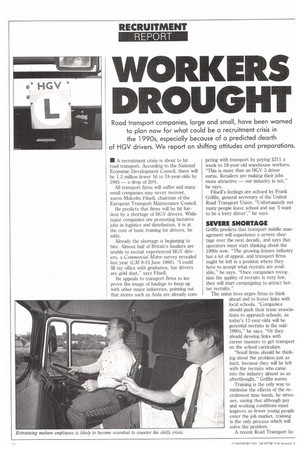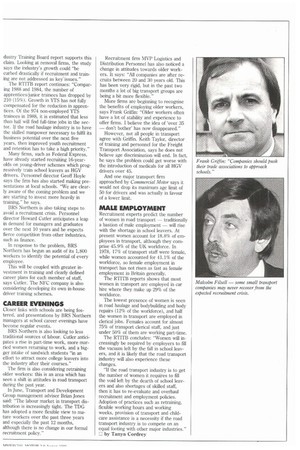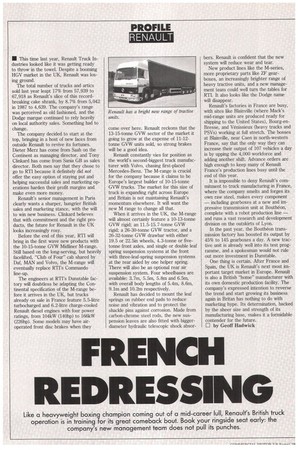WORKERS DROUGHT
Page 40

Page 41

Page 42

If you've noticed an error in this article please click here to report it so we can fix it.
Road transport companies, large and small, have been warned to plan now for what could be a recruitment crisis in the 1990s, especially because of a predicted dearth of HGV drivers. We report on shifting attitudes and preparations.
IN A recruitment crisis is about to hit road transport. According to the National Economic Development Council, there will be 1.2 million fewer 16 to 24-year-olds by 1995 — a drop of 20%.
All transport firms will suffer and many small companies may never recover, warns Malcolm Fusel!, chairman of the European Transport Maintenance Council.
He predicts that firms will be hit hardest by a shortage of HGV drivers. While major companies are promoting lucrative jobs in logistics and distribution, it is at the cost of basic training for drivers, he adds.
Already the shortage is beginning to bite. Almost half of Britain's hauliers are unable to recruit experienced HGV drivers, a Commercial Motor survey revealed last year (CM 9-15 June 1988). "I could fill my office with graduates, but drivers are gold dust," says Filsell.
He appeals to transport firms to improve the image of haulage to keep up with other major industries, pointing out that stores such as Asda are already corn
peting with transport by paying £211 a week to 18-year-old warehouse workers. "This is more than an HGV 3 driver earns. Retailers are making their jobs more attractive — our industry is not," he says.
Filsell's feelings are echoed by Frank Griffin, general secretary of the United Road Transport Union. "Unfortunately not many people leave school and say 'I want to be a lorry driver'," he says.
SEVERE SHORTAGE
Griffin predicts that transport middle management will experience a severe shortage over the next decade, and says that operators must start thinking about the 1990s now. "The growing leisure industry has a lot of appeal, and transport firms might be left in a position where they have to accept what recruits are available," he says. "Once companies recognise the quality of recruits is very low, they will start campaigning to attract better recruits."
The union boss urges firms to think ahead and to foster links with local schools. "Companies should push their trade associations to approach schools, as today's 12-year-olds will be potential recruits in the mid1990s," he says. "Or they should develop links with career masters to get transport on the school curriculum.
"Small firms should be thinking about the problem just as hard, because they will be left with the recruits who came into the industry almost as an afterthought," Griffin warns.
Training is the only way to minimise the effects of the recruitment time bomb, he stresses, saying that although pay and working conditions must improve as fewer young people enter the job market, training is the only process which will solve the problem.
A recent Road Transport In dustry Training Board report supports this claim. Looking at removal firms, the study says the industry's growth could "be curbed drastically if recruitment and training are not addressed as key' issues."
The RTITB report continues: "Comparing 1988 and 1984, the number of apprentices/junior trainees has dropped by 210 (15%). Growth in YTS has not fully compensated for the reduction in apprentices. Of the 974 non-employed YTS trainees in 1988, it is estimated that less than half will find full-time jobs in the sector. If the road haulage industry is to have the skilled manpower necessary to fulfil its business potential over the next five years, then improved youth recruitment and retention has to take a high priority."
Many firms, such as Federal Express, have already started recruiting 16-yearolds on young-driver schemes which progressively train school leavers as HGV drivers. Personnel director Geoff Hoyle says the firm has also started making presentations at local schools. "We are clearly aware of the coming problem and we are starting to invest more heavily in training," he says.
BRS Northern is also taking steps to avoid a recruitment crisis. Personnel director Howard Cutler anticipates a leap in demand for managers and graduates over the next 10 years and he expects fierce competition from other industries, such as finance.
In response to the problem, BRS Northern has begun an audit of its 1,800 workers to identify the potential of every employee.
This will be coupled with greater investment in training and clearly defined career plans for each member of staff, says Cutler. The NFC company is also considering developing its own in-house driver training schemes.
CAREER EVENINGS
Closer links with schools are being fostered, and presentations by BRS Northern managers at school career evenings have become regular events.
BRS Northern is also looking to less traditional sources of labour. Cutler anticipates a rise in part-time work, more married women returning to work, and a bigger intake of sandwich students "in an effort to attract more college leavers into the industry after their courses."
The firm is also considering retraining older workers: this is an area which has seen a shift in attitudes in road transport during the past year.
In June, Transport and Development Group management adviser Brian Jones said: The labour market in transport distribution is increasingly tight. The TDG has adopted a more flexible view to mature workers over the past three years and especially the past 12 months, although there is no change in our formal recruitment policy." Recruitment firm MVP Logistics and Distribution Personnel has also noticed a change in attitudes towards older workers. It says: "All companies are after recruits between 20 and 30 years old. This has been very rigid, but in the past two months a lot of big transport groups are being a bit more flexible."
More firms are beginning to recognise the benefits of employing older workers, says Frank Griffin: "Older workers often have a lot of stability and experience to offer firms. I believe the idea of 'over 35 — don't bother has now disappeared."
However, not all people in transport agree with Griffin. Keith Taylor, director of training and personnel for the Freight Transport Association, says he does not believe age discrimination will end. In fact, he says the problem could get worse with the introduction of medicals for all HGV drivers over 45.
And one major transport firm approached by Commercial Motor says it would not drop its maximum age limit of 50 for drivers and was actually in favour of a lower limit.
MALE EMPLOYMENT
Recruitment experts predict the number of women in road transport — traditionally a bastion of male employment — will rise with the shortage in school leavers. At present women account for 18.8% of employees in transport, although they comprise 45.9% of the UK workforce. In 1978, 17% of transport staff were female, while women accounted for 41.1% of the workforce, so female employment in transport has not risen as fast as female employment in Britain generally.
The RTITB reports shows that most women in transport are employed in car hire where they make up 29% of the workforce.
The lowest presence of women is seen in road haulage and bodybuilding and body repairs (12% of the workforce), and half the women in transport are employed in clerical jobs. Females account for almost 75% of transport clerical staff, and just under 50% of them are working part-time.
The RTITB concludes: "Women will increasingly be required by employers to fill the vacuum left by the fall in school leavers, and it is likely that the road transport industry will also experience these changes.
"If the road transport industry is to get the number of women it requires to fill the void left by the dearth of school leavers and also shortages of skilled staff, then it has to re-evaluate and overhaul recruitment and employment policies. Adoption of practices such as retraining, flexible working hours and working weeks, provision of transport and childcare assistance is a necessity if the road transport industry is to compete on an equal footing with other major industries." C by Tanya Cordrey • This time last year, Renault Truck Industries looked like it was getting ready to throw in the towel. Despite a booming HGV market in the UK, Renault was losing ground.
The total number of trucks and artics sold last year leapt 17% from 57,939 to 67,918 as Renault's slice of this recordbreaking cake shrank, by 8.7% from 5,042 in 1987 to 4,639. The company's range was perceived as old fashioned, and the Dodge marque continued to rely heavily on local authority sales. Something had to change.
The company decided to start at the top, bringing in a host of new faces from outside Renault to revive its fortunes. Dieter Merz has come from Saab on the Continent as managing director, and Tony Clinkard has come from Sania GB as sales director. Both men say that they chose to go to RTI because it definitely did not offer the easy option of staying put and helping successful sales and marketing operations harden their profit margins and make even more money.
Renault's senior management in Paris clearly wants a sharper, hungrier British sales and marketing stance, with the will to win new business. Clinkard believes that with commitment and the right products, the future for Renault in the UK looks increasingly rosy.
Before the end of this year, RTI will bring in the first wave new products with the 10-15-tonne GVW Midliner M-range. Still based on the long-serving, but heavily facelifted, "Club of Four" cab shared by Daf, MAN and Volvo, the M-range will eventually replace RTI's Commando line-up.
The engineers at RTI's Dunstable factory will doubtless be adapting the Continental specification of the M-range before it arrives in the UK, but trucks already on sale in France feature 5.5-litre turbocharged and 6.2-litre charge-cooled Renault diesel engines with four power ratings, from 104kW (140hp) to 166kW (226hp). Some models may have airoperated front disc brakes when they come over here. Renault reckons that the 13-15-tonne GVW sector of the market it going to grow at the expense of 11-12tonne GVW units sold, so strong brakes will be a good idea.
Renault constantly vies for position as the world's second-biggest truck manufacturer with Volvo, chasing first-placed Mercedes-Benz. The M-range is crucial for the company because it claims to be Europe's largest builder of 10-15-tonne GVW trucks. The market for this size of truck is expanding right across Europe and Britain is not maintaining Renault's momentum elsewhere. It will want the new M range to change all that.
When it arrives in the UK, the M-range will almost certainly feature a 10-13-tonne GVW rigid; an 11.5-15.7-tonne GVW rigid; a 26-30-tonne GVW tractor, and a 26-32-tonne GVW drawbar with either 19.5 or 22.5in wheels, 4.3-tonne or fivetonne front axles, and single or double leaf spring suspension systems at the front with three-leaf-spring suspension systems at the rear aided by one helper spring. There will also be an optional rear air suspension system. Four wheelbases are available: 3.7m, 5.5m, 5.8m and 6.5m, with overall body lengths of 5.4m, 8.6m, 9.1m and 10.2m respectively.
Renault has decided to mount the leaf springs on rubber end pads to reduce noise and vibration and to protect the shackle pins against corrosion. Made from carbon-chrome steel rods, the new suspension leaves are also fitted with biggerdiameter hydraulic telescopic shock absor bers. Renault is confident that the new system will reduce wear and tear.
New product lines like the M-series, more proprietary parts like ZF gearboxes, an increasingly brighter range of heavy tractive units, and a new management team could well turn the tables for RI!. It also looks like the Dodge name will disappear.
Renault's factories in France are busy, with sites like Blainville (where Mack's mid-range units are produced ready for shipping to the United States), Bourg-enBresse, and Venissieux (heavy trucks and PSVs) working at full stretch. The bosses at Blainville, near Caen in north-western France, say that the only way they can increase their output of 107 vehicles a day is by upping the 4,000 workforce and adding another shift. Advance orders are high enough to keep many of Renault France's production lines busy until the end of this year.
It is impossible to deny Renault's commitment to truck manufacturing in France, where the company smelts and forges its own raw steel, makes every component — including gearboxes at a new and impressive transmission unit at Boutheon, complete with a robot production line — and runs a vast research and development division on the outskirts of Lyon.
In the past year, the Boutheon transmission factory has boosted its output by 45% to 145 gearboxes a day. A new tractive unit is already well into its test programme, and a spokesman would not rule out more investment in Dunstable.
One thing is certain, After France and Spain, the UK is Renault's next most important target market in Europe. Renault is also a British "home" manufacturer with its own domestic production facility. The company's expressed intention to reverse the trend and start growing its business again in Britan has nothing to do with marketing hype. Its determination, backed by the sheer size and strength of its manufacturing base, makes it a formidable contender for the future.
by Geoff Hadwick




































































































